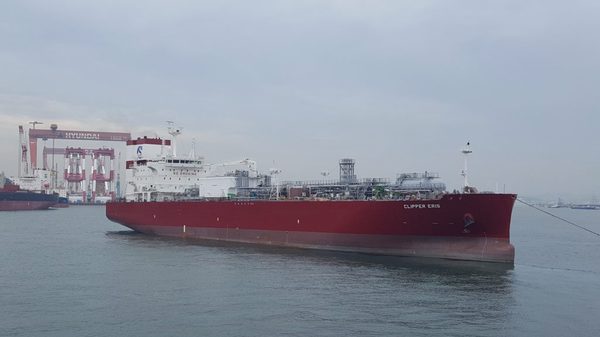Seatrium announces ‘full-scale turnkey pilot CCS retrofit’ project
Singapore-based shipbuilder Seatrium will retrofit Wärtsilä’s ready-to-use carbon capture and storage (CCS) system on a Solvang-owned LPG carrier.
 PHOTO: Solvang-owned LPG carrier, Clipper Eris. Solvang
PHOTO: Solvang-owned LPG carrier, Clipper Eris. Solvang
Seatrium will install an onboard CCS (OCCS) system developed by Finnish marine engine-maker Wärtsilä on Norwegian shipping company Solvang’s fossil fuel-powered LPG carrier, Clipper Eris.
Wärtsilä’s CCS system combines carbon dioxide (CO2) captured from a vessel’s exhaust gases with an amine-based solvent. The captured CO2 is then released from the solvent by heating to cause a chemical reaction that reverses the CO2 absorption.
Amines are nitrogen-containing organic compounds that help in absorption and regeneration of CO2.
The released CO2 gas will be then liquefied and stored cryogenically on the vessel using an integrated system, while the solvent is ready to be reused in another process.
It is possible to capture at least 70% of the CO2 emissions from the vessel’s exhaust gas, Wärtsilä claims. “Our [further] testing shows that the capture rate can likely reach 80% with a solvent optimised for marine engine exhaust gas,” it said on its website.
Onboard carbon capture technology offers "immediate potential to enable marine decarbonisation for both existing and newbuild vessels,” Sigurd Jenssen, director of Wärtsilä Exhaust Treatment said.
The retrofitting is expected to begin in the third quarter of this year.
“The technology will be piloted onboard the vessel over a year while it is operating commercially. If the pilot project is successful, Solvang intends to install the technology on some of our vessels, including newbuilds, thereby contributing to a faster take-up of the technology,” Tor Ask, fleet director of Solvang said.
Shipping’s growing interest in onboard carbon capture
The project shows a growing trend of maritime decarbonisation upgrades and retrofits that is expected to grow further in the near future, according to Alvin Gan, executive vice president of Seatrium Repairs and Upgrades.
The shipping industry is promoting carbon capture as a means to reduce the sector's carbon footprint. CO2 captured from vessels' emissions can be permanently stored deep underground or used to produce marine fuels like e-methanol, with zero-emission potential.
Classification societies DNV and ABS have highlighted OCCS as an option "beyond fuels" to combat maritime emissions.
DNV underscored that OCSS would allow ships to use fossil-based fuels while significantly reducing emissions. This would ease the burden of producing green and blue fuels, like e-methanol or blue ammonia, to meet shipping demand.
Several shipping companies are already exploring the use of CCS technology onboard vessels.
London-based Carbon Clean and South Korea's Samsung Engineering are exploring the possibility of installing modular carbon capture systems on existing ships. Meanwhile, Spanish engineering firm, Sener is looking to integrate OCCS into the design of LNG-powered newbuilds.
By Konica Bhatt
Please get in touch with comments or additional info to news@engine.online





